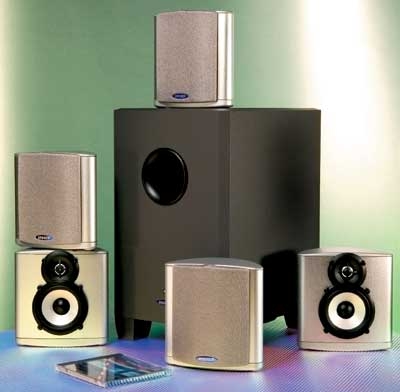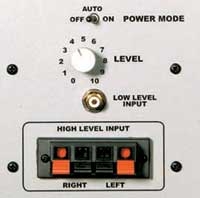Home Theater on a Budget Page 4
Energy act6Energy is no stranger to HToB systems. Its Take5 and Encore series have won nearly universal praise for their astute balancing of performance, cost, and style. Energy's newer, smaller act6 array follows the same winning formula: five identical small, classy-looking satellites with adaptable mounting hardware and a small-footprint subwoofer specifically designed to support them. Unlike the JBL and Hsu satellites, which have plastic enclosures, the Energy act1 is made of machined aluminum, which gives it a heftier, more luxurious "feel." 
SETUP I set up the act6 identically to the other systems. Like JBL's SCS300 satellite, Energy's act1 requires you to remove the supplied wall-mounting hardware to connect the speaker wires to the spring-clip terminals inset in its bottom.
|
MUSIC PERFORMANCE Up and running, the act6 system was the closest match to my "big" everyday rig, with very even, uncolored vocal tones and smooth, steady highs. Treble was a shade airier than the Hsu Research, but less bright than the JBL. The overall presentation on music was first-rate, with precise, solid imaging and well-balanced sound from everything I tried.
And this was equally true for multichannel music. The Canadian system pounded out stuff like the blues-rocker "One Dance with You" from the Vince Gill DVD-Audio disc with real authority, remaining crisp and clean up to surprisingly lifelike volumes. Among the three systems reviewed here, I'd guess that the Energy wins the loud/clean sweepstakes by a nose over the JBL.
MOVIE PERFORMANCE Soundtracks sounded excellent as well. The act6 beamed up a seamless front soundstage, presenting a cohesive image from the three front speakers and keeping The Italian Job's zillions of pans and shifts impressively together, never drawing attention from the action to an individual speaker. And the little Energy satellites worked well as surrounds when they were aimed about 30° rearward to bounce some sound off the back wall.
 Although Energy's subwoofer was the smallest of the lot, it had no problem keeping pace. And while it didn't quite match the Hsu or JBL subs in lowest-octave oomph, it came very close.
Although Energy's subwoofer was the smallest of the lot, it had no problem keeping pace. And while it didn't quite match the Hsu or JBL subs in lowest-octave oomph, it came very close.
Even the ultra-small satellites delivered a surprisingly robust midbass punch. To ease setup and get the best possible blend between the sats and sub, you'll want to use a receiver (or processor) with an adjustable crossover frequency - indeed, the same could be said of all three systems. I used a 110-Hz crossover frequency instead of the "standard" 80 Hz, but this is likely to vary from room to room.
For my taste, Energy's act6 is the most sophisticated-looking of these three systems. It also scored high with unusually refined sonics for stereo music and solid, dynamic surround performance - qualities that may well be worth the extra money to some listeners. PDF: Fast Facts PDF: In the Lab
The Bottom LineAre these mini marvels ready to kill off high-end home theater speakers once and for all? Of course not. But it would be hard to exaggerate how much better they are than the speakers that come with typical mass-market microsystems, and the more I listened, the more impressed I was with their remarkable value.
Do you demand a real eight-piece, 7.1-channel suite for not much more than five bills? JBL's got yours. Insisting on tiny satellites but reluctant to settle for lumpy low-end sound? Go see Hsu. Ready to upgrade to a home theater system with style and well-balanced sound but still need to save space? Take an Energy break. Whichever one you audition or select, you won't be disappointed.













































